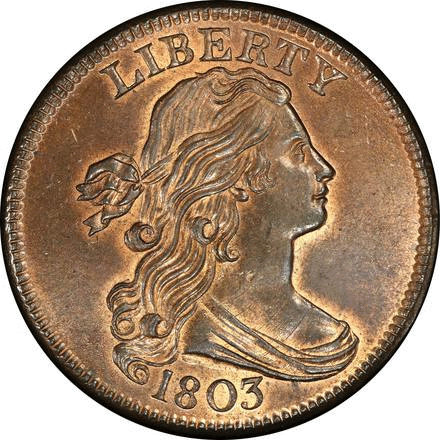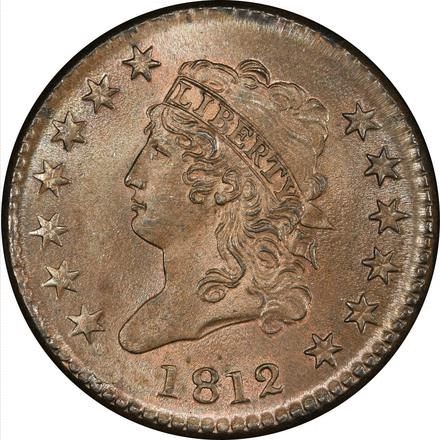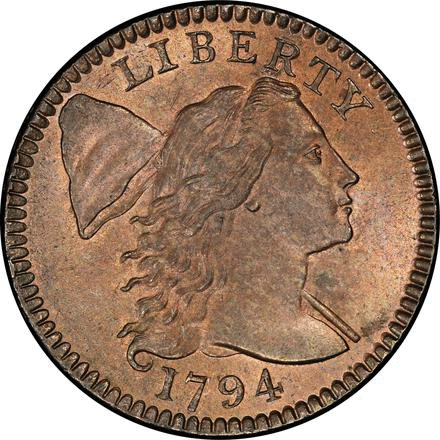Coin Rarities & Related Topics: News and Analysis regarding scarce coins, markets, and coin collecting #374
A Weekly CoinWeek Column by Greg Reynolds …..
For new collectors or seasoned collectors seeking new projects, there will be opportunities in the Pogue V sale on March 31, in Baltimore. An explanation of the venue and an overview of the contents of this auction were provided last week. Considerable discussion of the evolution of the Pogue Family Coin Collection was featured last week as well. The current topic is high-quality half cents and large cents for type sets.
People who cannot afford any of the coins in this sale may find themselves interested, too. Learning about unaffordable coins contributes to an understanding of the coins that respective collectors can afford and to an appreciation of the culture of coin collecting in the U.S.
Prior to the Pogue IV sale last May, I wrote an article about why collectors who cannot participate should care about the collection overall and about these five auctions. Additionally, people who assemble type sets of relatively high-grade coins share some interests with those who assemble type sets of lesser-grade U.S. type coins. They are interested in the same types of coins, monetary history, the history of coin collecting and/or the history of the United States Mint.
 The collecting of type coins brings rich and not-so-rich collectors together. While the finest-known 1796 Liberty Cap large cent sold for $690,000 USD in September 2008, a Good-04 grade coin would be likely to sell for less than $500. Good-04 grade large cents dated 1801, 1802 or 1803 of the 1796 to 1807, Draped Bust design type can be obtained for less than $100 each.
The collecting of type coins brings rich and not-so-rich collectors together. While the finest-known 1796 Liberty Cap large cent sold for $690,000 USD in September 2008, a Good-04 grade coin would be likely to sell for less than $500. Good-04 grade large cents dated 1801, 1802 or 1803 of the 1796 to 1807, Draped Bust design type can be obtained for less than $100 each.
Before discussing gem quality Pogue Collection coins, it should be emphasized that circulated, half cents and large cents may be effectively collected for modest amounts, given current markets for classic U.S. coins. A complete set of Draped Bust half cents (1800 to 1808) may be built without spending as much as $500 on any one coin, as explained in a past article. The same is true of a set of Classic Head half cents (1809 to 1835), though one date may have to be excluded.
In December 2015, I pointed out that a complete set of Classic Head large cents ‘by date,’ 1808 to 1814, may easily be completed for less than $500 per coin, with all coins being truly gradable and pleasing. Furthermore, circulated (sub-60 grade) Matron Head and Braided Hair large cents tend to be inexpensive.
For those who have a fortune to spend, however, there are mind-blowing large cents in the Pogue V sale.
 For a collector who enjoys gem-quality classic U.S. coins and does not already have a collecting plan or is considering a new quest, the Pogue V sale is ideally suited to acquire coins for a gem type set of large cents or half cents. Only one coin of each design type is needed for a type set. There are an incredible number of gem half cents and large cents in this sale, including many ‘early dates’ minted before 1815.
For a collector who enjoys gem-quality classic U.S. coins and does not already have a collecting plan or is considering a new quest, the Pogue V sale is ideally suited to acquire coins for a gem type set of large cents or half cents. Only one coin of each design type is needed for a type set. There are an incredible number of gem half cents and large cents in this sale, including many ‘early dates’ minted before 1815.
The Pogues collected large cents and half cents ‘by date’. While collectors in the 19th century tended to collect coins ‘by year’, the concept of ‘collecting by date’ has evolved such that readily recognizable and traditionally popular major varieties are typically classified as distinct dates.
As the Pogue Collection features multiple representatives of each design type, bidders seeking to build a type set do not need specific coins; they can choose among several. There is a good chance that much of an excellent type set of large cents and/or half cents may be obtained on March 31 without maniacal bidding. There is no need to ‘go crazy’ while pursuing any one coin, though some Pogue Collection large cents are so incredibly cool that it would be tempting to pay multiples of prevailing market levels for them.
Building a substantial part of a type set of large cents or half cents, perhaps even completing one, is a practical and sensible strategy for bidding in the Pogue V sale. Many of the Pogue Collection half cents were recently acquired in the Goldbergs sale of the Tettenhorst-Missouri Cabinet in January 2014.
Over the past 10 years, an incredibly large number of gem-quality large cents have emerged, especially in the sales of the Madison type set in January 2008, the Walter Husak Collection in February 2008, much of the Ted Naftzger Collection in 2008 and 2009, the Dan Holmes Collection in 2009 and 2010, the Cardinal set of large cents in 2013, and the Gene Gardner Collection in 2014 and 2015. Although there is always intense demand for gem large cents, the supply has been unusually large and thus there has been a series of opportunities for interested collectors that was previously unimaginable.
For high-quality half cents and large cents, it is best to start with a type set before thinking about collecting ‘by date’ or by die pairing. Collectors should decide on the types that are best for them and compute a collecting budget before starting.
 Types of Large Cents
Types of Large Cents
- Chain (1793 only)
- Wreath (1793 only)
- Liberty Cap (1793-96)
- Draped Bust (1796-1807)
- Classic Head (1808-14)
- Matron Head (1816-35)
- Gobrecht Head (1835-39)
- Braided Hair (1839-57)
Coins dated from 1793 to 1814 are ‘early dates’. Those dating from 1816 to 1839 are ‘middle dates,’and late dates end in 1857.
Some researchers argue that 1793 Liberty Cap cents constitute a one-year design type and thus the third one-year design type of that year. The border elements on 1793 Liberty Caps are beads or “dots”, while 1794 to 1796 Liberty Cap cents have dentils (sometimes called denticles), protective toothlike structures that point inward from the rim or edge. Other than this difference in border elements, however, 1793 Liberty Cap cents are extremely similar to 1794-96 Liberty Cap cents.
It is true that the staff at PCGS defines 1793 Liberty Cap cents as a distinct, one-year design type, which is held to be different from the ’94 to ’96 Liberty Cap large cent design type. Among type sets in the PCGS registry that include early large cents, each requires two Liberty Cap cents, necessarily a 1793 and a 1794, 1795 or 1796 Liberty Cap cent.
The PCGS approach in this regard is not synchronized with the coin community. All Liberty Cap cents, 1793 to 1796, are categorized as being of the same design type in Krause Publications, in some or all Whitman books, on numismedia.com and at NGC. There is unanimous agreement that Chain cents and Wreath cents are each one-year design types.
Pogue Collection Chain and Wreath cents, along with 18th-century half cents, were auctioned in the Pogue III sale on February 9, 2016. Are all other Pogue Collection large cents and all 19th-century half cents to be found in the upcoming Pogue V sale? There are a massive number that are PCGS-certified as grading from MS-65 to MS-67, thus apparently in the gem-quality range.
Although there is no mention of CAC in the catalogue, many of the coins in this sale passed at CAC. It is best to avoid generalizations and think about the reasons why each specific coin of interest did or did not pass at CAC. Generally, it is extremely beneficial to discuss the coins with honest experts before bidding.
In September 2008, I focused on the Beckwith-Naftzger-Pogue 1796 Liberty Cap cent. It would have been logical for this coin to have received exceptional publicity in 2017. In 2008, it was PCGS-certified as ‘MS-66 RB’ and it has an amazing amount of original mint red color. PCGS has since added a plus and it is now certified as ‘MS-66+ RB’ and is CAC-approved.
It is likely that this Beckwith-Naftzger-Pogue coin is the finest-known 1796 Liberty Cap cent and is one of the five-finest-known Liberty Cap cents of any date. Its color is superior to that of the nearly flawless, Jung-Pogue 1794 Apple Cheek cent, which is also in the Pogue V sale.
 The Oswald-Husak-Cardinal 1794 ‘Head of 1795’ is a terrific coin, too.
The Oswald-Husak-Cardinal 1794 ‘Head of 1795’ is a terrific coin, too.
It was PCGS-certified as ‘MS-67 RB’ in 2007 and failed at CAC in 2012. While that Oswald-Husak-Cardinal 1794 rates higher in the technical category than this Beckwith-Naftzger-Pogue 1796, the 1796 is much livelier. The Oswald-Husak-Cardinal coin realized $488,750 on Feb. 15, 2008 and $499,375 on Jan. 24, 2013 in the Stack’s-Bowers auction of the Cardinal Collection of large cents.
Almost all of Ted Naftzger’s ‘Early Date’ (1793-1814) large cents were purchased by Eric Streiner in 1992. Naftzger, however, retained a few without telling many people he had done so.
After Naftzger’s death in 2007, a short run of his ‘Early Date’ cents was consigned to the Goldbergs-McCawley-Grellman sale in September 2008. This piece then realized $690,000, which set an auction record for a copper coin. His ‘middle date’ and ‘late date’ large cents were auctioned in 2009.
This $690,000 record has since been broken on several occasions. In January 2015, the Parmelee-Brand-Naftzger 1793 Chain Cent was auctioned by Heritage for $2,350,000.
For this Beckwith-Naftzger-Pogue 1796 cent, the current catalogue estimate of “$160,000“ to “$200,000” is puzzling. Although market levels are lower now than they were in 2008, and the $690,000 result in 2008 was unquestionably strong, there are quite a few people assembling very high quality type sets of U.S. coins.
Besides, an auction result in September 2008 is not the same as a result in June, July or early August 2008, the period in which markets for rare coins were peaking. Stock markets crashed at least twice in September 2008, on the 15th and on the 29th. Coin markets had then been heading downward since some point in August.
For this Beckwith-Naftzger-Pogue 1796 cent, the PCGS price guide value is $650,000. For the whole design type, the PCGS price guide base value for a ‘MS-66+ RB’ Liberty Cap cent is $275,000. Overall, 1794 large cents are much more common than 1796 Liberty Cap cents. This coin should bring far more than $275,000 on March 31.
As for the other design types of large cents, there are numerous representatives in this sale that are each PCGS-graded from MS-65 to MS-67. I recollect viewing the Sheldon-Naftzger-Holmes-Cardinal 1805 Draped Bust large cent in 2009 and in 2013. It was PCGS-certified as ‘MS-66-Brown’ with a CAC sticker. It has since been upgraded to “66+”. The green and steel brown blend is memorable.
In September 2009, this 1805 brought $184,000 in the sale of Dan Holmes’ Early Date large cents. In January 2013, this same coin went for $152,750. It may turn out to be a good value if attention is deflected from it by the the Beckwith-Eliasberg-Pogue 1805, which is PCGS-certified as ‘MS-65-RB’.
There are too many highly certified, ‘middle date’ and ‘late date’ large cents in this sale to cover in this brief preview. Collectors of type coins may wish to focus on several, rather than becoming too excited about any one coin. At auctions, some coins will bring unexpectedly strong prices and others will bring more moderate prices. It is not a good idea to attempt to predict the auction results.
Half Cents
Pogue Family Collection 18th-century half cents were auctioned by Stack’s-Bowers in the Pogue III sale on February 9, 2016. There has been considerable debate regarding the precise classifications of design types of 18th-century half cents. As only 19th-century half cents are in the Pogue V sale, 18th-century half cents may be ignored at the moment.
 There are just three design types of 18th-century U.S. half cents: Draped Bust (1800-08), Classic Head (1809-36) and Braided Hair (1840-57). Although circulated Draped Bust half cents of most dates are not hard to find, gem pieces are a different matter. PCGS and NGC population data include multiple counts of some of the same coins, and few assigned grades are very controversial.
There are just three design types of 18th-century U.S. half cents: Draped Bust (1800-08), Classic Head (1809-36) and Braided Hair (1840-57). Although circulated Draped Bust half cents of most dates are not hard to find, gem pieces are a different matter. PCGS and NGC population data include multiple counts of some of the same coins, and few assigned grades are very controversial.
It is likely that there are less than 20 Draped Bust half cents in existence that pertinent experts whom I know would grade MS-65 or MS-66. There are none that grade higher than 66. Moreover, there are not a large number that grade or should grade in the MS-64 range. There are an astonishing number in the Pogue V sale that are PCGS-graded from MS-64 to MS-66+. No comments about individual half cents are being put forth here. This offering certainly constitutes an incredible opportunity to pursue a gem or very choice-quality Draped Bust half cent.
It is newsworthy that there are a dozen Classic Head half cents in this sale that are PCGS-graded MS-66 or MS-66. Of course, there are differences in quality, color and originality among them. Nevertheless, the depth of the offering is amazing. This is certainly an excellent sale from which to select one gem Classic Head half cent for a type set. Of course, not all 12 should be considered and prices realized for these will vary considerably. Expert advice should be sought.
As for Braided Hair half cents, the emphasis in the Pogue Family Coin Collection seems to have been on Proofs rather than on business strikes. There may be opportunities for collectors who are already familiar with such Proofs and are interested. Other prospective bidders should perhaps tend towards business strike large cents and half cents, for which the Pogue V sale will be fondly remembered for generations.
© 2017 Greg Reynolds





